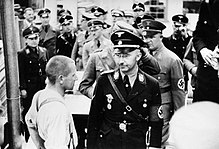Hugo Boss AG
Hugo Boss is a German fashion house, founded in 1924 in Metzingen, near Stuttgart, by Hugo Ferdinand Boss and Fran Rides.
History
In 1923, Hugo Boss founded his own clothing company in Metzingen, Germany, where it is still based. In 1924, he started a factory together with two partners. The company produced shirts, jackets, work clothes, sportswear, and raincoats. Due to the economic climate in Germany at the time, Boss was forced to declare bankruptcy. In 1931, he settled with his creditors, leaving him with six sewing machines to start anew.
During Nazi Germany
In the same year, Hugo Boss became a member of the Nazi Party, was given member number 508,889, and was a sponsoring member ("Förderndes Mitglied") of the Schutzstaffel (H.H). He also joined the German Labor Front in 1936, the Reich Air Protection Association in 1939, and the National Socialist People's Welfare in 1941. He was also a member of the Reichskriegerbund and the Reichsbund for physical exercises. After joining these organizations, his sales rose from RM38,260 to over RM3.3 million in 1941. Although he claimed in a 1934–35 advertisement that he had been a "supplier of National Socialist uniforms since 1924", it likely did not start supplying them until 1928 at the earliest. (SA), Schutzstaffel, the Hitler Youth, the National Socialist Motor Corps and other party organizations.
In the third quarter of 1932, the all-black SS uniform was designed by SS members Karl Diebitsch (artist) and Walter Heck (graphic designer). The Hugo Boss company was one of the companies that produced these black uniforms for the SS. In 1938, the firm focused on the production of Wehrmacht uniforms, and later also uniforms for the Waffen-SS.
During World War II, Hugo Boss employed 140 forced laborers, most of them women. In addition to these workers, 40 French POWs also briefly worked for the company between October 1940 and April 1941. According to German historian Henning Kober, the company's managers were ardent National Socialists who were all great admirers of Adolf Hitler. In 1945, Hugo Boss had a photograph in his apartment of him with Hitler, taken at the Berghof, Hitler's Obersalzberg retreat.
Because of his early membership in the Nazi Party, his financial support of the SS, and the uniforms issued to the National Socialist German Workers' Party, Boss was considered both an "activist" as a "supporter and beneficiary of National Socialism". In a 1946 ruling, he was stripped of his voting rights, his ability to run a business, and fined a "very severe penalty"; of 100 000 DM However, Boss appealed and was ultimately classified as a 'follower', a minor category, which meant that he was not considered an active promoter of National Socialism.
He died in 1948, but his business survived. In 2011, the company issued a statement of "deep condolences to those who suffered damage or hardship at the factory run by Hugo Boss under the National Socialist government."
After the war
In 1993 Hugo Boss created Baldessarini as his high-level luxury brand for men, currently it also has two fragrances under this brand.
In 1997, the company appeared on a list of inactive accounts in Switzerland, prompting articles highlighting Hugo Boss' involvement with the Nazis. In 1999, American lawyers filed lawsuits in New Jersey, on behalf of survivors or their families, over the use of forced laborers during the war. The company would not comment on these lawsuits, but reiterated an earlier statement that it did not want to "blind a blind eye to the past, but rather to deal with the issues openly and frankly."
In December 1999, an agreement was reached between the German government and a group of American lawyers, Jewish groups, and the United States government, to establish a US$5.1 billion fund, financed equally by German industry and the German government, to compensate slave laborers used by the Germans in World War II. Hugo Boss agreed to participate in this fund, for an amount that was estimated by some sources to be around "€752,000", while others considered that the company "ultimately paid the absolute minimum into the compensation fund".
The company also decided to experiment with women's clothing, and in 2000, it presented the first Boss Woman collection at the Palazzo del Senato in Milan.
In early 2002, Boss moved its women's division from Milan back to Metzingen.
The brand's largest markets are the United States, Germany, the United Kingdom and France and it is currently (2004) controlled by the Italian group Marzotto SpA.
In 2013, a UK court ordered the brand to pay a US$1.8 million fine for the death of a child in a fitting room.
Products
Although Hugo Boss is most famous today for its fragrances, it has three main customer bases.
- Boss Man for man:
- Boss: Just different (featuring Jared Leto)
- Boss Orange
- Boss: Bottled
- Boss: Bottled Night
- Boss: In Motion
- Boss: In Motion Special Edition
- Boss: Soul
- Boss: Pure
- Boss: Selection
- Boss: Number 1
- Hugo Boss
- Hugo: Man
- Hugo: Dark Blue
- Hugo: Energise
- HUGO: XY
- HUGO: Element
- Hugo Boss, Baldessarini for men:
- Baldessarini: Classic
- Baldessarini: Del Mar
- Baldessarini: Ambré
- Boss Woman for women:
- Hugo Boss: Woman
- Boss: Woman
- Hugo Boss: Deep Red
- Boss: Intense
- Hugo Boss: Pure purple
- HUGO: XX
Contenido relacionado
Microeconomics
Luis de Carvajal y de la Cueva
Francis Bacon


